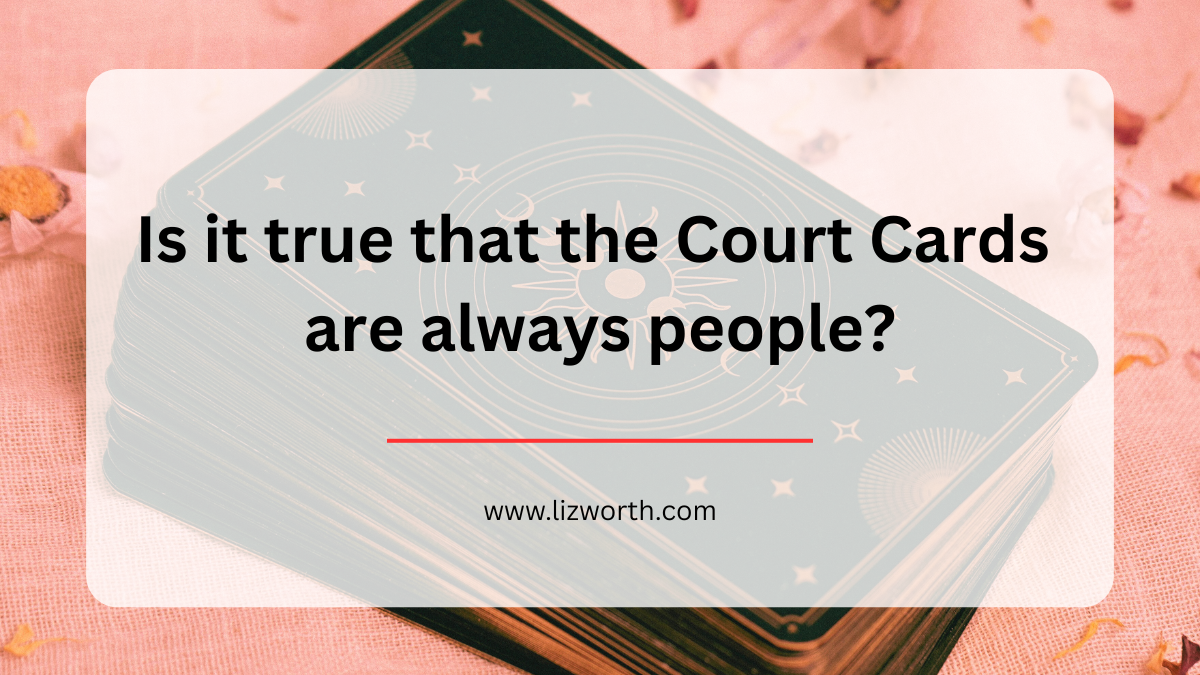Is it true that the Court Cards are always people?

Were you taught that the tarot’s court cards are always people? Learn where that idea comes from, and how to build new interpretations with the courts
Were you taught that the tarot’s court cards are always people?
This is how I first learned to look at them, and I know that’s a common experience.
Just last month, I was meeting with a student who said they had just taken a tarot course that taught the court cards are people.
But the problem with seeing the court cards only as people is that it limits what their interpretations can be.
Like the rest of the tarot pack, the courts are multi-dimensional images, not static meanings. Every card in the deck, including the courts, can represent an action, a feeling, a situation, an archetype, an energy, a state of being, or other insight into the question at hand.
I know that sounds like a mouthful: How can any reader keep track of so many possibilities?
But I find that it’s when we allow ourselves to have a lot of possibilities within the cards that our intuition has more of an opportunity to step in. It gives your intuition room to play and connect the dots.
While it can seem easy to learn tarot if we look at the cards as simple, quick lists to memorize, this approach actually makes tarot harder to learn to a certain extent because it can box in your interpretations.
And it can make you second-guess what you’re seeing: “When should I listen to my intuition about a card, and when should I go with the rote meaning?”
It can also stand in the way of building your own associations with the cards. When you read tarot over a long period of time, you start to notice that standard card meanings don’t always apply.
So where did the idea that court cards are people come from, anyway?
The idea to interpret court cards as people isn’t new.
Tarot began as a card game in medieval Italy in the 1400s, but gradually evolved into a divinatory tool.
Tarot concepts of the 1900s and 2000s still owe much to French occultism of the 1700s and 1800s, when occultists like Jean-Baptiste Alliette (also known as Etteilla) and Antoine Court de Gébelin began putting their philosophies about tarot onto paper. Their writings give us some early examples of tarot’s suits being assigned to people, at least in terms of broader social classes.
Batons (now Wands) were farmers. Cups were clergy. Coins (now Pentacles) were merchants. And Swords were nobles.
Petit Lenormand cards, named for French cartomancer Marie Anne Lenormand and first published in the 1800s, included cards to represent people.
In 1931, W. Gurney Benham’s book, Playing Cards, examined the vast history of card game packs, including standard fortune-telling meanings for 52-card game packs. There, we see the Kings, Queens, and Knights (or Knaves) listed as people as well.
Many contemporary associations with the court cards likely started to derive from Eden Gray’s books, such as A Complete Guide to the Tarot, published in 1970. Gray’s writings did a lot to introduce tarot to a new generation, taking tarot reading out of the complex, secretive realm of occult societies and making it mainstream.
Gray offered interpretations for the courts as people, as well as assignations for signifier cards, though she also included other ways to look at them if those did not apply.
As tarot’s popularity blossomed throughout the New Age revival of the ‘70s and beyond, ideas about the court cards as people would have carried on as well.
So is it wrong to look at the court cards as people?
No. Court cards are based on human roles: Kings, queens, knights, and pages are all roles people have filled throughout the centuries.
But sometimes the way we are taught to look at them – with specific personality traits, or limited physical appearances that don’t add up in this wide, diverse world – doesn’t seem to fit.
And sometimes, readings are not about other people at all: They are personal, and speak to internal desires and functions that can’t be outsourced to external influences.
Understanding that the court cards have a long history in divination helps us to remember that, like the rest of our tarot pack, the courts have changed with the times, too.
And the more avenues through which we can interpret them, the better equipped we are as tarot readers to find new, insightful connections when reading for ourselves, or for querents.
If you’re interested in learning practical, reliable methodologies to expand your understanding of the court cards, and add some new tools to your tarot practice, you might want to check out my online classes. Details are here.
Until next time,
Liz
Categories: : court cards, tarot card meanings
 Liz Worth
Liz Worth 